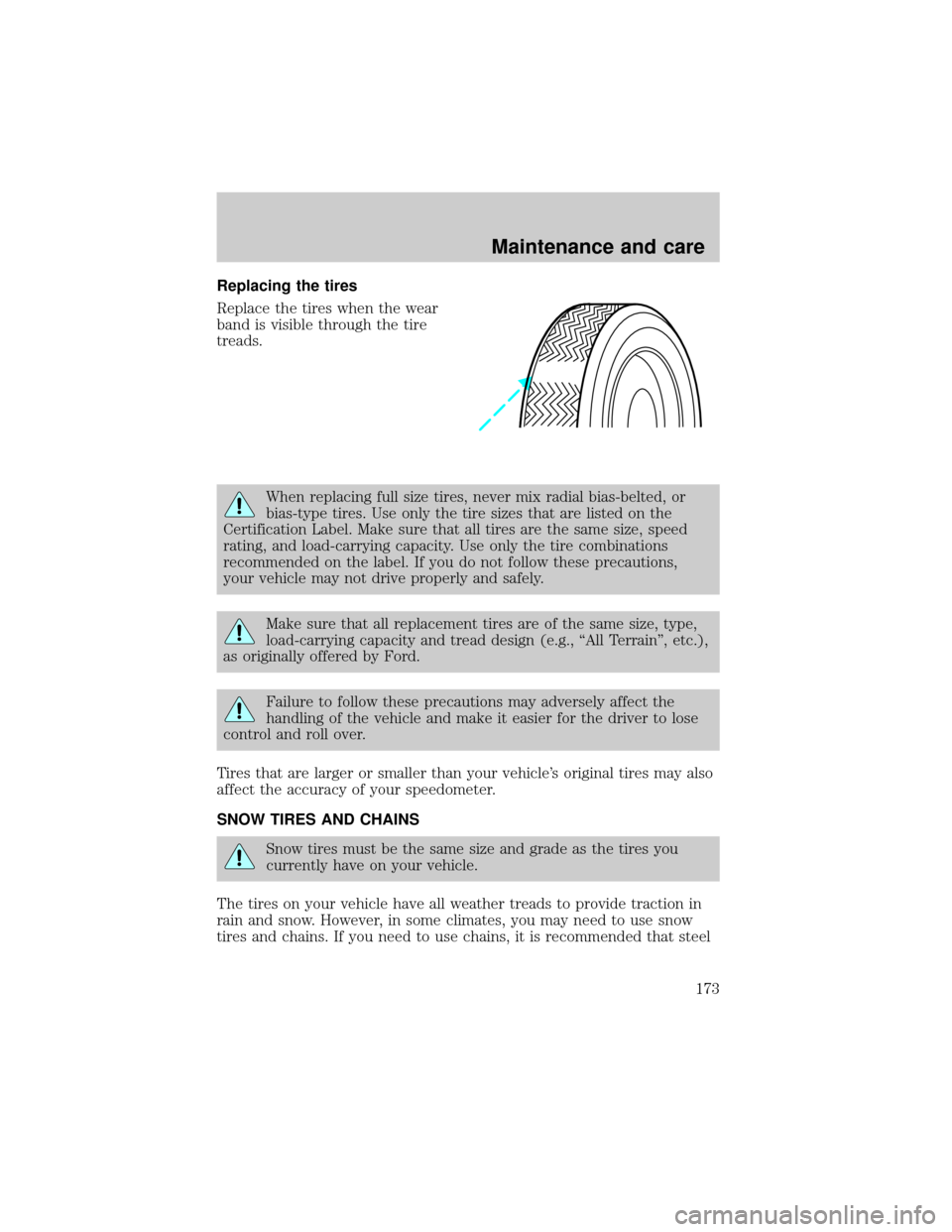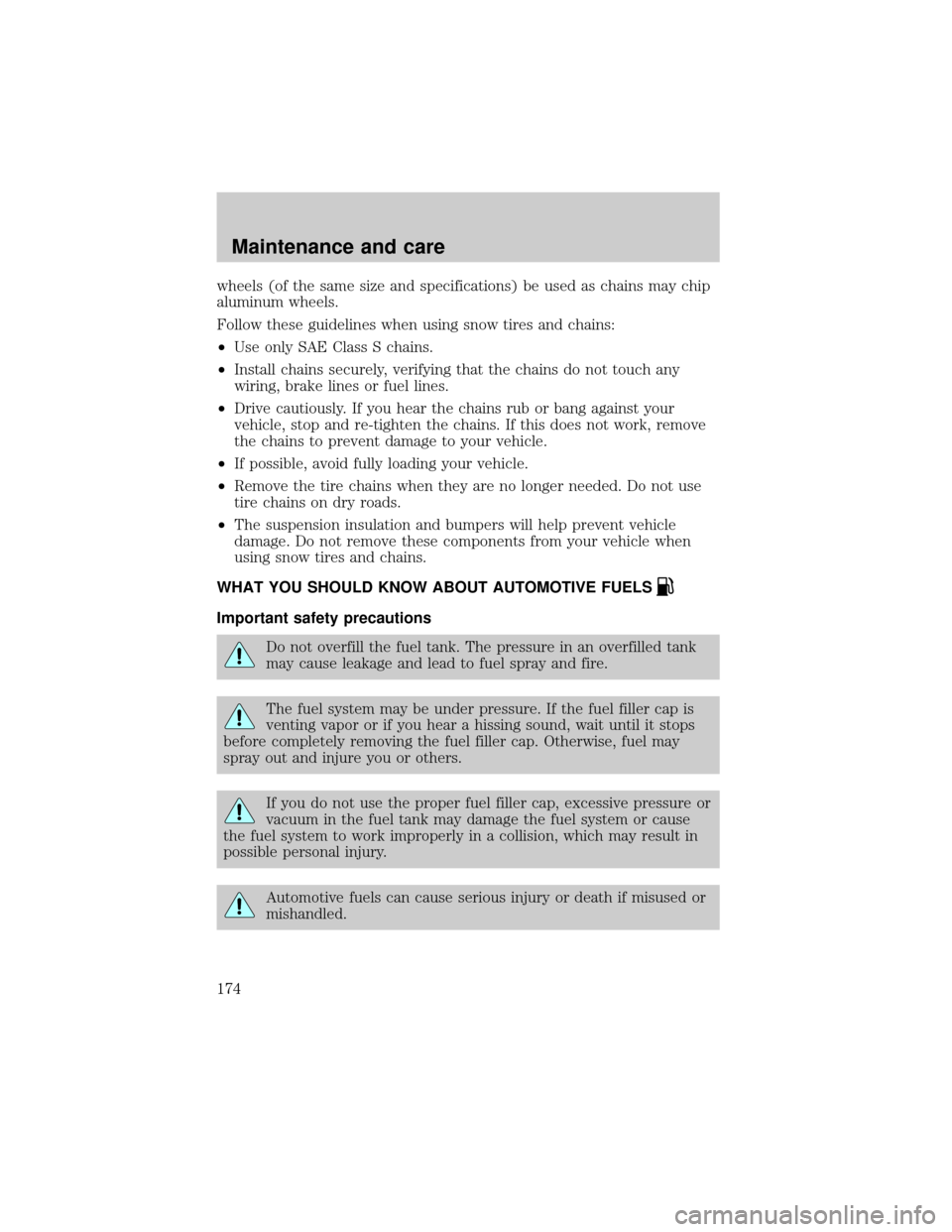Page 173 of 224

Replacing the tires
Replace the tires when the wear
band is visible through the tire
treads.
When replacing full size tires, never mix radial bias-belted, or
bias-type tires. Use only the tire sizes that are listed on the
Certification Label. Make sure that all tires are the same size, speed
rating, and load-carrying capacity. Use only the tire combinations
recommended on the label. If you do not follow these precautions,
your vehicle may not drive properly and safely.
Make sure that all replacement tires are of the same size, type,
load-carrying capacity and tread design (e.g., ªAll Terrainº, etc.),
as originally offered by Ford.
Failure to follow these precautions may adversely affect the
handling of the vehicle and make it easier for the driver to lose
control and roll over.
Tires that are larger or smaller than your vehicle's original tires may also
affect the accuracy of your speedometer.
SNOW TIRES AND CHAINS
Snow tires must be the same size and grade as the tires you
currently have on your vehicle.
The tires on your vehicle have all weather treads to provide traction in
rain and snow. However, in some climates, you may need to use snow
tires and chains. If you need to use chains, it is recommended that steel
Maintenance and care
173
Page 174 of 224

wheels (of the same size and specifications) be used as chains may chip
aluminum wheels.
Follow these guidelines when using snow tires and chains:
²Use only SAE Class S chains.
²Install chains securely, verifying that the chains do not touch any
wiring, brake lines or fuel lines.
²Drive cautiously. If you hear the chains rub or bang against your
vehicle, stop and re-tighten the chains. If this does not work, remove
the chains to prevent damage to your vehicle.
²If possible, avoid fully loading your vehicle.
²Remove the tire chains when they are no longer needed. Do not use
tire chains on dry roads.
²The suspension insulation and bumpers will help prevent vehicle
damage. Do not remove these components from your vehicle when
using snow tires and chains.
WHAT YOU SHOULD KNOW ABOUT AUTOMOTIVE FUELS
Important safety precautions
Do not overfill the fuel tank. The pressure in an overfilled tank
may cause leakage and lead to fuel spray and fire.
The fuel system may be under pressure. If the fuel filler cap is
venting vapor or if you hear a hissing sound, wait until it stops
before completely removing the fuel filler cap. Otherwise, fuel may
spray out and injure you or others.
If you do not use the proper fuel filler cap, excessive pressure or
vacuum in the fuel tank may damage the fuel system or cause
the fuel system to work improperly in a collision, which may result in
possible personal injury.
Automotive fuels can cause serious injury or death if misused or
mishandled.
Maintenance and care
174
Page 218 of 224

memory seat ...................69,76,88
SecuriLock passive anti-theft
system ................................80,81,82
Servicing your vehicle ..............150
Spark plugs,
specifications ......................195,198
Specification chart,
lubricants ............................197,198
Speed control ..............................56
Speedometer ...............................16
Starting your vehicle .........114,116
jump starting ..........................144
Steering
speed sensitive .......................122
Steering wheel
controls ......................................60
tilting .........................................55
Tilt steering wheel ......................55
Tires ......................140,170,171,172
changing ...........................140,141
checking the pressure ............172
replacing ..................................173
rotating ....................................172
snow tires and chains ............173
tire grades ...............................171
treadwear ................................171
Towing ................................128,172
trailer towing ..........................128
wrecker ....................................149
Traction control ........................120active light ................................13
how to enable/disable ............121
off light ......................................12
Traction-lok rear axle ...............126
Transmission .............................123
fluid, checking and adding
(automatic) .............................164
fluid, refill capacities ..............195
lubricant specifications ...197,198
Trunk ...........................................83
remote release .....................66,73
Turn signal ........................10,14,55
Vehicle dimensions ...................198
Vehicle Identification
Number (VIN) ...........................201
Vehicle loading ..........................127
Ventilating your vehicle ...........117
Warning chimes ...........................14
Warning lights (see Lights) .........8
Washer fluid ..............................157
Water, Driving through .............131
Windows
power .........................................67
Windshield washer
fluid and wipers
checking and adding fluid .....157
checking and cleaning ............169
operation ...................................56
replacing wiper blades ...........169
Wrecker towing .........................149
Index
218